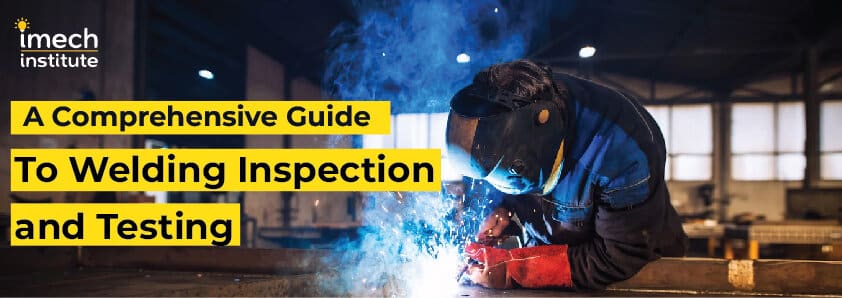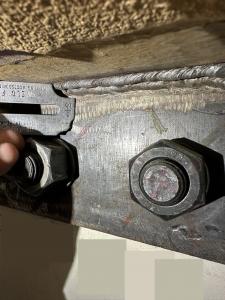Ingenious Techniques to Fillet Weld Examination and Screening: Enhancing Weld Top Quality and Compliance Criteria
In the realm of welding, the quality and stability of fillet welds play an important role in making certain the architectural stability and reliability of various industrial parts. With the constant drive for enhanced performance and conformity with strict criteria, the expedition of ingenious techniques to fillet weld inspection and testing has come to be crucial.
Advanced Non-Destructive Screening Techniques
Using modern modern technologies, progressed non-destructive screening techniques play an important role in making sure the stability and high quality of fillet welds. These methods, such as phased variety ultrasonic testing (PAUT) and magnetic particle screening (MPT), offer detailed understandings into the weld's internal structure without creating any kind of damages to the material. PAUT, for circumstances, uses multiple ultrasonic components to evaluate the weld from different angles, supplying a thorough visualization of potential issues like lack of combination or cracks.
By utilizing these innovative non-destructive testing methods, weld inspectors can accurately analyze the high quality of fillet welds, ensuring compliance with sector criteria and policies. The ability to detect problems early on not just boosts weld high quality however also protects against pricey rework or failings in architectural integrity, underscoring the value of these ingenious testing methods in welding assessments.
Robotics and Automation in Assessment
The integration of robotics and automation has revolutionized the examination process for fillet welds, boosting efficiency and accuracy in top quality assessment. Robotics supply exact control and repeatability in checking welds, ensuring trustworthy and regular outcomes. Automated systems can be configured to follow specific examination paths, ensuring complete coverage of welds and decreasing the danger of human error.
Robotic assessment systems outfitted with innovative sensors can find and determine weld attributes with high precision, offering thorough information for analysis. These systems can determine defects such as fractures, absence of blend, and porosity, making it possible for timely corrective activities to be taken. In addition, robotics and automation permit real-time data collection and analysis, providing prompt feedback to drivers and helping with quick decision-making processes.
Furthermore, using robotics and automation in fillet weld examination boosts overall productivity by minimizing inspection times and raising assessment throughput. By improving the examination procedure, producers can make sure weld top quality and conformity criteria are met successfully, eventually causing set you back financial savings and boosted product top quality.
Using Expert System for Analysis
Fabricated intelligence plays a crucial role in enhancing the effectiveness and precision of evaluation in fillet weld examination procedures. AI formulas can rapidly refine huge amounts of data from weld assessments, discovering defects or variances that may be challenging to identify with the naked eye - Welding Inspection Racine.
Moreover, AI systems can gain from past inspection information, consistently enhancing their ability to determine potential issues and inconsistencies in find out this here fillet welds. This flexible understanding capability enhances the general quality assurance process, reducing the possibility of human mistake and ensuring that welds fulfill the needed requirements. By incorporating expert system into fillet weld analysis, industries can attain higher degrees of efficiency, consistency, and conformity in their evaluation techniques.
Portable Devices for On-Site Examination
 Enhancing area inspection performance, the fostering of mobile devices revolutionizes on-site evaluation processes for fillet welds. These devices use adaptability and benefit, enabling assessors to conduct complete examinations in numerous locations, consisting of remote or challenging atmospheres. Mobile tools such as ultrasonic screening devices, magnetic particle examination tools, and electronic radiography systems offer real-time information and high-resolution imaging capabilities, enabling fast decision-making and Extra resources prompt responses on weld top quality.
Enhancing area inspection performance, the fostering of mobile devices revolutionizes on-site evaluation processes for fillet welds. These devices use adaptability and benefit, enabling assessors to conduct complete examinations in numerous locations, consisting of remote or challenging atmospheres. Mobile tools such as ultrasonic screening devices, magnetic particle examination tools, and electronic radiography systems offer real-time information and high-resolution imaging capabilities, enabling fast decision-making and Extra resources prompt responses on weld top quality.One significant benefit of mobile tools is their capacity to improve evaluation procedures, decreasing downtime and improving general efficiency. Examiners can easily carry these tools to various task sites, removing the requirement for carrying heavy machinery or elements to off-site centers. Furthermore, the mobility of these devices advertises cost-effectiveness by minimizing transport costs and speeding up evaluation timelines.
Additionally, using portable tools for on-site assessment advertises proactive quality assurance steps, as examiners can promptly recognize and address any kind of prospective welding issues or discrepancies. By integrating these cutting-edge technologies right into on-site examination techniques, welding experts can make certain conformity with market criteria and enhance weld quality, inevitably bring about enhanced structural stability and security in different welding applications.
Assimilation of Data Monitoring Systems
Having actually maximized on-site assessment procedures with the use of mobile devices, the following phase includes the smooth combination of information administration systems to further improve effectiveness and data evaluation capabilities in fillet weld examination and screening. Welding Inspection Racine. By incorporating information management systems into the inspection process, companies can streamline data collection, storage space, and evaluation. This combination permits real-time tracking of weld quality, prompt identification of flaws, and punctual decision-making to remedy any concerns that may occur throughout the inspection procedure
The combination of data administration systems makes it possible for seamless interaction in between various stakeholders involved in the examination process, cultivating collaboration and enhancing overall high quality control procedures. Ultimately, the integration of data monitoring systems serves to elevate the criteria of fillet weld site web evaluation and testing, ensuring compliance with market regulations and boosting weld high quality.
Final Thought
Finally, innovative methods to fillet weld inspection and testing have actually dramatically boosted weld high quality and compliance requirements. Advanced non-destructive testing methods, robotics, automation, expert system, portable tools, and data monitoring systems have revolutionized the method weld inspections are conducted. By using these technologies, markets can make sure that welds satisfy the required top quality standards and guidelines, eventually enhancing overall performance and safety in welding processes.

By employing these advanced non-destructive screening methods, weld assessors can properly evaluate the quality of fillet welds, making certain compliance with sector standards and regulations. Portable tools such as ultrasonic screening tools, magnetic bit inspection devices, and digital radiography systems give real-time information and high-resolution imaging capabilities, allowing fast decision-making and prompt feedback on weld high quality.
Having actually optimized on-site assessment processes with the usage of portable tools, the next stage includes the smooth integration of information administration systems to further enhance efficiency and data analysis abilities in fillet weld evaluation and testing (Welding Inspection Racine). Inevitably, the combination of information administration systems serves to boost the standards of fillet weld inspection and testing, ensuring compliance with industry regulations and boosting weld top quality
 In conclusion, ingenious methods to fillet weld evaluation and testing have considerably improved weld top quality and conformity standards.
In conclusion, ingenious methods to fillet weld evaluation and testing have considerably improved weld top quality and conformity standards.